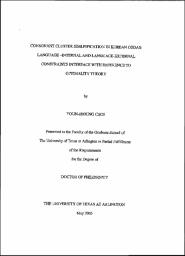
ATTENTION: The works hosted here are being migrated to a new repository that will consolidate resources, improve discoverability, and better show UTA's research impact on the global community. We will update authors as the migration progresses. Please see MavMatrix for more information.
Show simple item record
| dc.contributor.author | Choi, Youn-Jeoung | |
| dc.date.accessioned | 2020-10-09T19:55:16Z | |
| dc.date.available | 2020-10-09T19:55:16Z | |
| dc.date.issued | 2005-05 | |
| dc.identifier.uri | http://hdl.handle.net/10106/29497 | |
| dc.description.abstract | In Korean, when a morpheme contains a coda cluster in its underlying form (such as /salm/‘life,’ /hulk/‘soil’), we observe two outcomes in its surface representation. In cases when the morpheme followed by either another consonant or by a word boundary, the cluster is simplified by deleting one consonant. However, if a vowel-initial morpheme follows the underlying cluster, the second member of the cluster assumes the role of a syllable onset. Contrary to prescriptive accounts in which both the deleted consonant and the results of resyllabification are claimed to be completely predictable, observation of contemporary Korean usage suggest that there is variation in terms of how cluster reduction and resyllabification are realized. With respect to the phonological phenomena of morpheme-final consonant clusters in Korean, this study examines both theoretical and empirical aspects of the phenomena. As for the theoretical aspects, this study attempts to provide an explanation regarding the phonological properties of the surviving (or deleted) segment by employing Optimality Theory. In addition, by means of quantitative data analysis, this study investigates not only patterns of variation but also social factors governing the variation with relation to consonant cluster simplification in Korean. By considering both theoretical and empirical aspect of the phenomena, this study pursues a more satisfactory explanation for consonant cluster simplification in Korean, and furthermore suggests Optimality Theory as a formal model for integrating these two aspects of this linguistic phenomenon. | en_US |
| dc.language.iso | en_US | en_US |
| dc.publisher | University of Texas at Arlington | en_US |
| dc.subject | Language | en_US |
| dc.subject | Literature and linguistics | en_US |
| dc.subject | Cluster simplification | en_US |
| dc.subject | Codas | en_US |
| dc.subject | Consonant | en_US |
| dc.subject | Korean | en_US |
| dc.subject | Optimality | en_US |
| dc.title | CONSONANT CLUSTER SIMPLIFICATION IN KOREAN CODAS: LANGUAGE-INTERNAL AND LANGUAGE-EXTERNAL CONSTRAINTS INTERFACE WITH REFERENCE TO OPTIMALITY THEORY | en_US |
| dc.type | Dissertation | en_US |
| thesis.degree.department | Linguistics | |
| thesis.degree.name | Doctor of Philosophy in Linguistics | |
Files in this item
- Name:
- Consonant Cluster Simplification ...
- Size:
- 6.741Mb
- Format:
- PDF
- Description:
- PDF
This item appears in the following Collection(s)
Show simple item record


